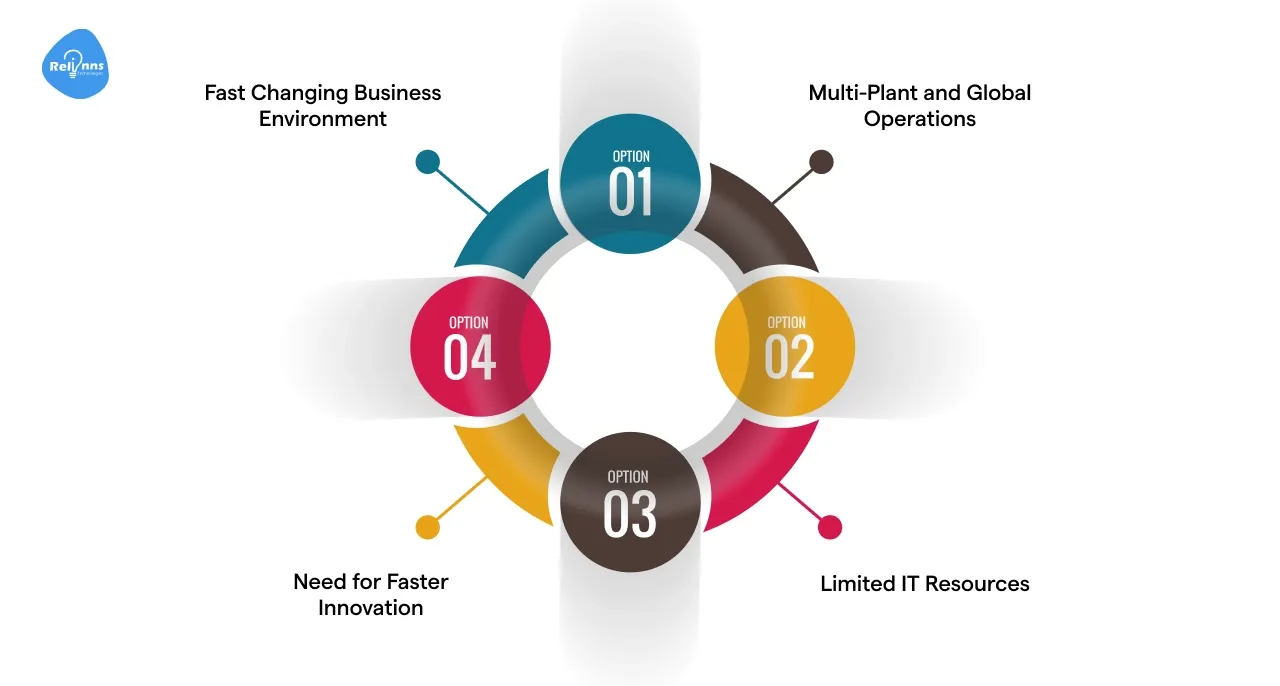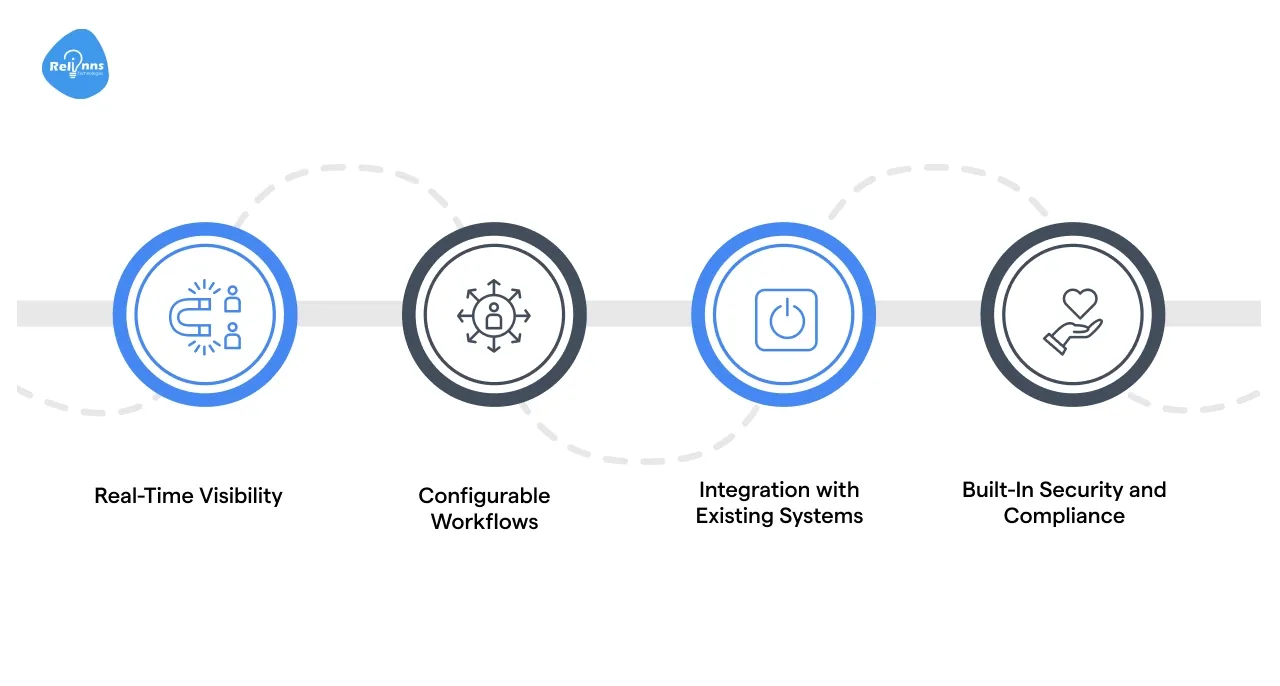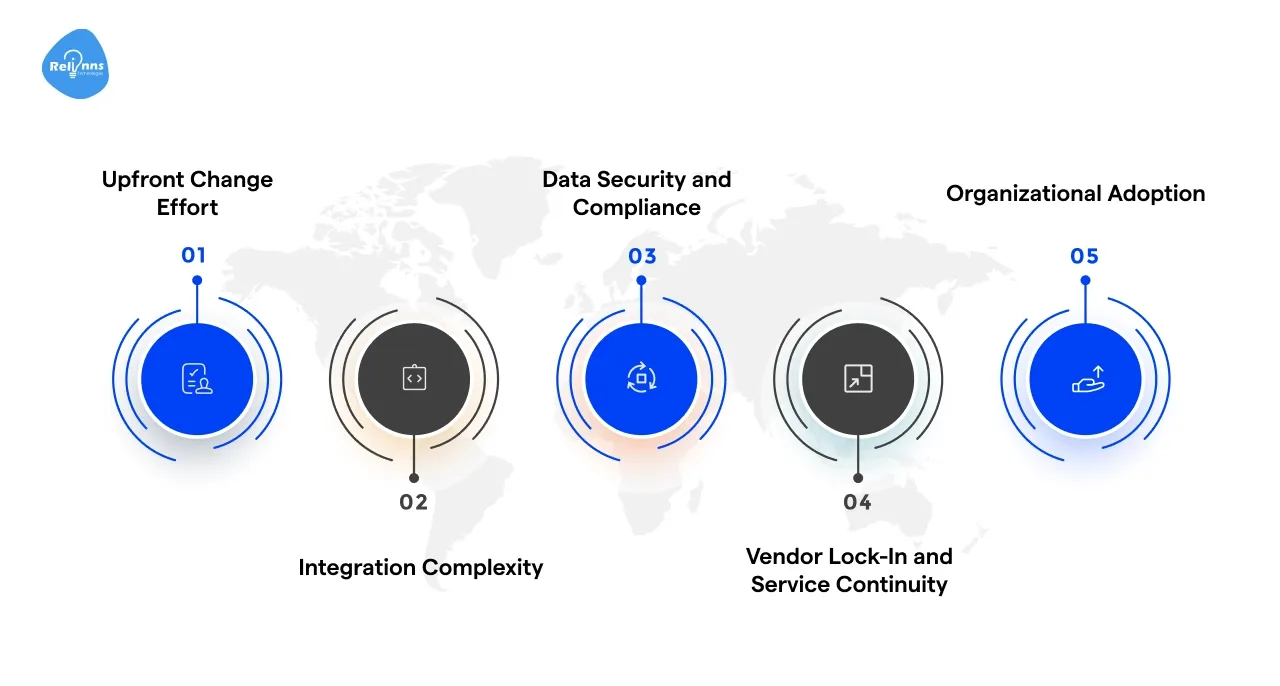SaaS for Manufacturing: Optimize Production with Cloud-Based Solutions
Date
Nov 17, 25
Reading Time
9 Minutes
Category
Enterprise Solutions

Manufacturers are under pressure to produce more, at better margins, with fewer surprises. Traditional on-premises software often becomes a bottleneck when product lines change, suppliers shift, or new regulations are introduced.
This is where saas for manufacturing comes in. Instead of running every system on local servers, manufacturers subscribe to cloud applications for planning, execution, quality, maintenance, and analytics. These tools update continuously, connect across plants, and scale as the business grows.
With thousands of manufacturing SaaS vendors and billions in new investments, the question is no longer whether to adopt SaaS, but how to use it well.
This guide explains what SaaS means in a manufacturing context, where it delivers the most value, the risks to manage, and how to choose a saas solution for manufacturing that genuinely improves day-to-day operations.
What is SaaS for Manufacturing?
SaaS, or Software as a Service, delivers applications over the internet on a subscription basis. The vendor hosts, maintains, and updates the software, while users access it through a browser or a lightweight client.
The global SaaS market is projected to grow from about 315 billion dollars in 2025 to more than 1.13 trillion dollars by 2032, with manufacturing among the fastest-rising segments.
In manufacturing, SaaS usually covers systems such as
- Cloud ERP and MRP for finance, materials, and basic production planning
- Manufacturing Execution Systems (MES) that track and control work on the shop floor
- Quality, maintenance, and supply chain applications that share data through APIs
A modern manufacturing execution system, for example, provides a layer between ERP and process control, monitoring and documenting every step from raw material to finished product. When delivered as SaaS, the same capabilities are available from any plant or device with secure internet access.
This model supports flexible, cloud-based SaaS solutions for manufacturers that can be rolled out plant by plant and line by line, without large hardware projects or long upgrade cycles.
Why and When Manufacturers Choose SaaS for Manufacturing

Not every factory will move all systems to the cloud at once. Certain conditions make saas for manufacturing especially attractive. Such as:
1. Fast Changing Business Environment
Manufacturers with frequent product launches, short customer lead times, or volatile demand need fast system changes.
SaaS platforms usually release features more often and allow configuration without deep custom coding, which helps keep processes aligned with the market.
2. Multi-Plant and Global Operations
Groups with multiple plants or contract manufacturers often struggle to standardize processes across locations.
Cloud platforms provide a single shared system with local variations as needed, simplifying reporting, compliance, and supplier collaboration.
3. Limited IT Resources
Many mid-size manufacturers lack dedicated teams for server maintenance, backups, and patching.
With SaaS, the vendor manages infrastructure, security updates, and high availability so that internal teams can focus on process improvement rather than hardware maintenance.
4. Need for Faster Innovation
The manufacturing SaaS segment includes more than 2,000 companies worldwide, with hundreds of funded vendors experimenting with new features, AI models, and integrations.
Choosing SaaS lets manufacturers benefit from this pace of innovation without rebuilding every system themselves.
Core Capabilities of Manufacturing SaaS Platforms

Most manufacturing SaaS offerings share a few foundational capabilities, even if they target different functions.
1. Real-Time Visibility
Cloud MES and quality systems collect data from machines, operators, and sensors, then present live dashboards for throughput, scrap, downtime, and energy.
Managers can see the state of every line without waiting for end-of-day reports.
2. Configurable Workflows
Good platforms allow non-developers to design forms, workflows, and approval routes through drag-and-drop tools.
This keeps small changes, such as a new inspection step or label rule, out of long IT queues.
3. Integration with Existing Systems
Cloud applications typically include APIs and connectors to ERP, PLM, WMS, and CRM systems. This supports a connected data model rather than islands of information.
MES, for example, can read orders from ERP and push actuals back without manual rekeying.
4. Built-In Security and Compliance
Vendors invest heavily in encryption, access control, and compliance frameworks because they serve many clients on shared infrastructure.
Manufacturing-focused solutions also include features such as audit trails and electronic signatures, where regulators expect them.
Key Benefits of SaaS for Manufacturers
When implemented with clear goals, a saas solution for manufacturing delivers benefits that go beyond reduced server work.
1. Lower Upfront Cost and Predictable Spend
On-premise systems usually require significant capital expenditure for hardware, licenses, and data center upgrades.
SaaS turns most of this into operational expense, with subscription fees that scale with usage. The global SaaS market’s growth is powered partly by this shift in cost structure.
2. Flexibility and Scalability
A cloud MES or planning tool can start at one site and expand to others as the model proves itself.
Seats, modules, and storage can increase or decrease based on actual demand. This flexibility is one of the most substantial benefits of SaaS for manufacturers operating in seasonal or project-based sectors.
3. Faster Time to Value
Because infrastructure is already in place, implementations focus on configuration, data migration, and training rather than lengthy hardware setup.
Many manufacturers report faster go-lives for manufacturing SaaS than for on-premises equivalents, especially in MES and supply chain domains.
4. Continuous Improvement Through Updates
Vendors deploy new features, UI enhancements, and performance improvements.
Customers receive these updates with minimal disruption, which keeps process capabilities evolving rather than frozen at the version installed years ago.
5. Better Collaboration Across the Value Chain
Cloud platforms make it easier to share selected data with suppliers, logistics partners, or contract manufacturers.
Shared forecasts, inventory levels, and quality data provide a single source of truth, reducing stockouts, overproduction, and dispute cycles.
6. Stronger Analytics and AI Readiness
Centralized cloud data is easier to feed into analytics models, AI planners, and predictive maintenance tools.
B2B SaaS is growing rapidly as companies seek data-rich platforms that support AI, with the market expected to more than triple between 2025 and 2030.
Manufacturing can ride that same wave by choosing platforms that expose clean, well-structured data.
Suggested Reading: Best Practices for Automating Warehouse Management Workflows
Comparison Table: Manufacturing SaaS vs On-Premise Systems
Before exploring specific use cases, it’s essential to understand how SaaS platforms differ from traditional on-premise systems. This comparison highlights the operational, financial, and scalability advantages that matter most to manufacturers.
| Evaluation Area | Manufacturing SaaS | On-Premise Manufacturing Systems |
| Deployment Speed | Weeks with configuration | Months due to hardware + setup |
| Upfront Cost | Low (subscription-based) | High (servers, licenses, infra) |
| Scalability | Add plants, lines, users instantly | Requires new hardware + IT upgrades |
| Updates | Automatic, continuous | Manual, costly, infrequent |
| Security | Vendor-managed, standardized | Internal team must maintain |
| Multi-Plant Visibility | Native cloud dashboards | Complex integrations needed |
| Integration | API-first, easier connectors | Depends on legacy compatibility |
| AI & Analytics | Easier with centralized data | Harder due to siloed databases |
| Total Cost of Ownership | Predictable OPEX | High and unpredictable CAPEX |
| Vendor Dependence | Higher | Lower, but with internal costs |
Top Use Cases of SaaS in Manufacturing
Manufacturing SaaS is not a single product. It shows up in distinct use cases that support everyday work on the plant floor and beyond.
Production Planning and Scheduling
Cloud planning tools help planners build feasible schedules that consider materials, machines, labor, and changeovers. They update when orders change and provide visibility across plants, which is vital when serving multiple customers with tight lead times.
Manufacturing Execution and Quality
SaaS-based MES records operations, work orders, and parameters at each step. Combined with cloud QMS modules, it supports electronic records, in-process checks, and deviation workflows.
This is particularly valuable in regulated industries such as medical devices and aerospace.
Maintenance and Asset Management
Cloud maintenance systems manage work orders, preventive schedules, and spare parts. When tied to sensor data, they support predictive maintenance that reduces unplanned downtime and extends equipment life without detailed in-house data science.
Inventory and Warehouse Management
SaaS WMS and inventory tools track materials from receipt to shipment, often across multiple locations. Real-time stock levels, reorder points, and traceability reports help avoid both shortages and excess holding.
IoT and Smart Factory Integration
Many flexible cloud-based SaaS solutions for manufacturers include IoT gateways or integrate with existing platforms. Machine data flows into central dashboards, where teams can monitor energy use, scrap patterns, and cycle times across all plants.
Suggested Reading: How to Set Up Joget Warehouse Automation Workflow
Challenges and Risk Factors with Manufacturing SaaS

The shift to SaaS is not risk-free. Manufacturers need a realistic view of challenges before committing.
Upfront Change Effort
Subscription models reduce capital spend, but the time and focus required to redesign processes, cleanse data, and train users are still significant. Without a clear benefit case, projects can stall midway.
Integration Complexity
SaaS platforms must coexist with existing PLCs, on-prem ERP, and legacy databases. Poorly planned integrations can create duplicate data or fragile interfaces. A clear architecture and tested API strategy are crucial for long-term stability.
Data Security and Compliance
Moving production data to the cloud introduces security and privacy concerns.
Although recognized vendors invest heavily in security, manufacturers still need robust access controls, network design, and vendor audits to meet internal and external requirements.
A survey report by WTW found that among 400 senior manufacturing executives, 53% said cybersecurity was among their greatest risks to business success, reflecting how technological transformation (including SaaS/cloud) increases risk exposure.
Vendor Lock-In and Service Continuity
Long-term reliance on a single provider can become a risk if pricing, product direction, or ownership changes. The recent pressure on traditional SaaS from AI-native competitors shows how quickly the landscape can shift.
Manufacturers should favour vendors with export capabilities, open standards, and reasonable exit clauses.
Organizational Adoption
New tools succeed only if people use them correctly. Without proper change management and role-based training, users may cling to spreadsheets and side systems, limiting the benefits of the central SaaS platform.
How to Choose the Right SaaS Solution for Manufacturing
Selecting saas for manufacturing is less about buzzwords and more about fit. A structured approach makes the choice easier.
Clarify Priority Outcomes
Start with three to five concrete outcomes such as improved schedule adherence, reduced scrap in a specific process, or better on-time delivery. These become the lens through which you evaluate every feature, rather than chasing long checklists.
Assess Functional Coverage and Industry Fit
Look for vendors that already serve your type of manufacturing process, discrete or hybrid. Public references, analyst reviews, and case studies around MES, ERP, and quality for your industry help validate that the core workflows are understood.
Evaluate Integration and Data Strategy
Confirm that the platform connects to your ERP, PLM, and shop-floor systems via modern APIs and standard protocols. Review how it structures master data, transactions, and histories so that analytics and AI can be applied later.
Review Security, Compliance, and Hosting Options
Check certifications, backup strategies, regional data centers, and options for customer-specific encryption keys. For regulated industries, verify support for audit-ready records, e-signatures, and validation documentation.
Validate Total Cost of Ownership
Subscriptions are only part of the cost. Include implementation, training, integration, and internal resources in your analysis. Compare this complete picture against the current price of downtime, rework, manual reporting, and legacy maintenance.
How Relinns Delivers Manufacturing SaaS Application That Improves Plant Performance?
Technology alone does not optimize a plant. The right partner helps translate tools into practical outcomes on the shop floor.
Relinns works with manufacturers to design and implement SaaS solutions for manufacturing that match real constraints and goals rather than generic templates.
Drawing on experience in workflow automation, low-code platforms, and integration projects, the team helps clients connect ERP, MES, quality, and maintenance systems into a single, coherent cloud ecosystem.
Why Manufacturers Partner with Relinns
- Process-first approach that starts from bottlenecks and KPIs instead of features alone
- Experience with low-code and integration platforms that accelerate configuration and rollout
- End-to-end delivery from discovery and design to implementation, training, and support
- Scalable architectures suitable for pilots in one plant and later rollout across regions
By combining industry insight, cloud expertise, and structured change management, Relinns helps manufacturers leverage manufacturing SaaS to drive real performance improvement, not just another IT project.
Conclusion: Maximizing Efficiency with SaaS for Manufacturing
SaaS has moved from a general business trend to a serious strategic option in manufacturing. The SaaS market for manufacturing is growing rapidly, with billions of dollars in new solutions for production planning, execution, quality, maintenance, and supply chain coordination.
For manufacturers, the attraction is clear. Cloud platforms reduce upfront cost, increase flexibility, and provide real-time visibility across plants and partners. When carefully selected and well integrated, they support continuous improvement and prepare the ground for AI, advanced analytics, and innovative factory initiatives.
The challenge is not simply to “move to the cloud,” but to pick specific areas where a saas solution for manufacturing can relieve real constraints and deliver measurable gains.
With the proper roadmap and partner, SaaS becomes less of a buzzword and more of a practical tool for stable, profitable, and future-ready operations.
Frequently Asked Questions (FAQ's)
How is SaaS for manufacturing different from traditional on-premise systems?
SaaS is hosted and maintained by the vendor, accessed over the internet, and updated frequently, while on-premise systems rely on local servers, manual upgrades, and higher internal maintenance effort.
Can SaaS handle complex, regulated manufacturing environments?
Yes, many manufacturing SaaS platforms include MES and QMS features such as electronic records, traceability, and audit trails that support regulated sectors like medical devices, aerospace, and pharmaceuticals.
Is SaaS suitable for small and mid-size manufacturers with limited IT staff?
Often it is ideal. Vendors manage infrastructure and security, so smaller teams can focus on process improvement instead of server upkeep, while still accessing advanced planning and shop-floor tools.
How does SaaS contribute to smart factory and IIoT initiatives?
SaaS platforms integrate machine, sensor, and system data in the cloud, enabling centralized dashboards, analytics, and AI that support predictive maintenance, energy optimization, and cross-plant performance comparison.
What are the main risks when moving to manufacturing SaaS?
Key risks include integration complexity, data security concerns, vendor lock-in, and weak user adoption. Clear architecture, contracts, and change management plans significantly reduce these issues.
How should a manufacturer start with SaaS if everything is still on-premises?
A practical path is to pilot one focused use case, such as cloud quality management or maintenance, prove value, refine governance, then extend the model to other plants and processes over time.



